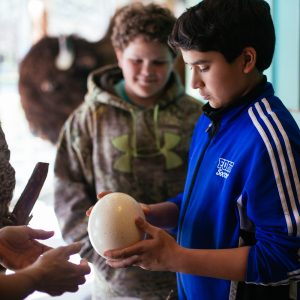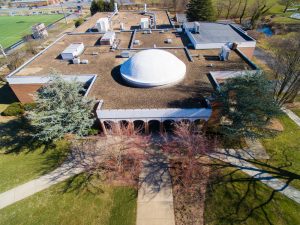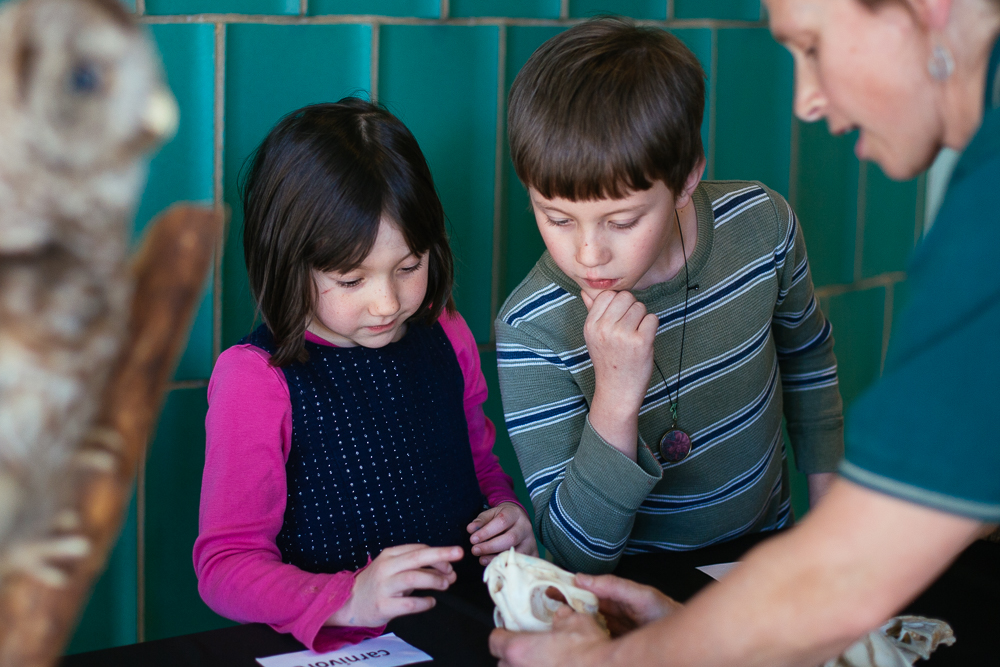The D. Ralph Hostetter Natural History Museum at Eastern Mennonite University, which has entranced thousands of schoolchildren since the 1960s, has launched a new outreach program that brings their collection to classrooms through the Shenandoah Valley.
Lessons are provided by bilingual outreach educator Janelle Hust de Mazariegos. The former language, cultures and social studies teacher at Thomas Harrison Middle School presents Standards of Learning (SOL)-based curricula in hands-on science lessons.

“These interactive programs put students into the exciting roles of young scientists and explorers,” she says. “It is a new experience for most kids to observe and touch shark jaws, rattlesnake fangs, fossils, a variety of minerals, and many other captivating treasures from our Natural History Museum.”
Students wowed by specimens and samples
Four programs for kindergarteners through fifth graders, developed by museum education director Maureen Gallon, are offered.
Animal Adaptation uses taxidermied specimens to demonstrate how animals’ bodies allow them to eat, move and thrive. “We talk about how it wouldn’t be very conducive for us to have duck feet in PE class,” says Mazariegos, laughing. Students greet each new artifact with the chorus, “Is that real!?”
Explore Our World examines underground, forested, and underwater habitats and the different kinds of life, food webs and interactions that occur in each. Students also learn about the effects of human impact on habitat.
Rocks, Minerals & Fossils uses geological samples to teach about the Earth’s prehistoric ages, the geological cycle as well as different classes of rocks and minerals. A mammoth tooth and prehistoric shark tooth help introduce fossils.
Watershed Science, currently in development, will explore riparian systems, the functions of different bodies of water, and the water cycle. A table-top model demonstrates watershed issues like erosion and pollution.
The program costs $90 for a 1-hour classroom session for up to 25 students, $130 for two sessions, and $160 for three sessions.
Area teacher: Lessons provide fun test review

Hurst de Mazariegos has conducted 11 programs in six local schools since December and is now ready to travel through the central Shenandoah Valley from Charlottesville to Winchester. Expansion of the program to older age groups and additional lessons such as an avian unit is planned for next year.
Fifth-grade teacher Marilee Billhimer said her students at Fulks Run Elementary School were thrilled and engaged by the rocks and fossils program, which offered a good review of SOL terms and concepts.
“It was a wonderful review for the state test coming up,” says Billhimer. “The students were really interested in the samples of rocks and minerals, which were much larger than any we had in the classroom. They were completely amazed at the fossil samples, which were numerous and also large. It was a great hands-on experience for them.”
Major renovations in the works

Since 1968, the museum in the Suter Science Center has hosted thousands of schoolchildren each year from as far as Charlottesville and Winchester. Many visitors will remember the two-headed calf, the giant bison, and the mummified hand, said Professor Jim Yoder, museum curator.
“Those curiosities are probably the most memorable, but we also have many other specimens, including minerals, animals, insects, a large African elephant skull and more than 3,000 artifacts from around the world,” he said. “We didn’t want that outreach to stop during our renovations.”
Currently closed, the museum is slated for renovations as part of the Suter West Campaign that will give the collection the prominence it deserves. By simply replacing the solid walls of the former Discovery Room, originally built as a planetarium and located just inside the science center’s main entrance, with glass panels and installing glass doors to the other primary museum room, adjacent to the main lobby, the visibility of EMU’s collection will be dramatically improved.
Additional funding will help preserve specimens, replace other aging specimens and provide updated signage and lighting.
New displays will include fewer items but explore topics in greater depth and offer greater opportunity for interaction. These cases will also allow for easier rotation of exhibits grouped by theme, such as Virginia wildlife, East African birds, Egyptian artifacts and anthropological specimens from Native American and African cultures.
Learn more about booking the mobile museum or about how to support the Suter West Campaign.
Andrew Jenner and Lauren Jefferson contributed to this article.

Informative. Great idea to go to the schools with mobile unit.